![]()
A123 (LiFePO4) Cells for Receiver Packs - 8/22/2009, revised 10/26/2009, 8/23/2010
|
|
A123 (LiFePO4) Cells for Receiver Packs - 8/22/2009, revised 10/26/2009, 8/23/2010 |
|
DISCLAIMER: These articles are the findings and opinions of one person. Any cell technology that we use is potentially dangerous. Do not work with these cells if you do not have a healthy respect for them, or if you lack the requisite skills. |
|
Since the early digital proportional radios, nickel-cadmium (NiCad) cells were the mainstay of both transmitter (TX) and receiver (RX) power.
Early receiver packs consisted of four 600-milliamp-hour (mah) cells.
This provided a nominal 4.8 volts plus a center-tap required by early servos.
This basic pack has remained a standard (sans center-tap) for over four decades.
Unfortunately, improvements in NiCad cells have essentially stopped due to environmental concerns.
Development has been focused on nickel-metal-hydride (NiMH) cells.
These cells exhibit essentially the same discharge characteristics as NiCad cells.
New cells are being introduced with higher and higher capacities.
There has been a trend for some time to use 5-cell packs for greater capacity and servo power.
Additionally, digital servos and giant scale aircraft have placed larger amp demands on the packs.
Use of 5-cell packs is predicated on the equipment being able to handle the higher voltage without damage or loss of performance.
Almost all receivers can handle the additional voltage.
Most modern servos are designed to handle 5 cells.
Check your servos' specs to be sure.
|
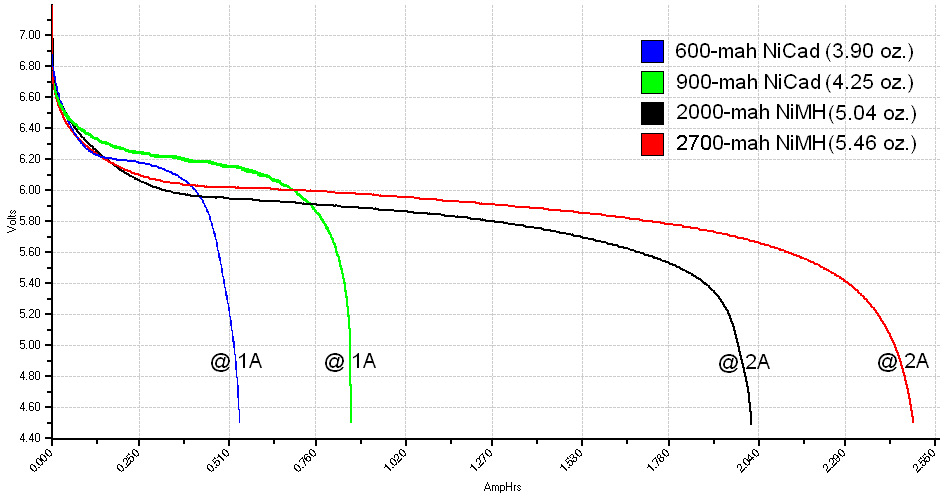 |
|
The curves above show differences in performance of some 5-cell packs.
The lowest capacity pack is made of cells from a "standard" NiCad RX pack.
The next is a new 900-mah Sanyo NiCad pack.
The two NiCad packs were discharged at 1000 milliamps, while the NiMH were discharged at 2000 milliamps.
That accounts for some of the voltage difference.
The rest is due to lower internal resistance in the NiCad cells.
It was assumed that the higher-capacity packs would be used with higher current demands.
The remaining two get close to their advertised capacity.
The 2700-mah pack is also by Sanyo, who always seems to excel at making cells.
All packs are the same size (AA).
The NiMH packs are clearly superior from a capacity and energy/weight standpoint.
However, there are some downsides.
Charging NiMH cells is an exothermic process, that is, heat is generated.
Heat is the enemy of cells.
Charging NiCad cells, on the other hand, is primarily an endothermic process.
The charging process actually cools the cell.
The weasel word is "primarily". When the NiCad cell approaches full charge, there is an increase in temperature.
Temperature monitoring is sometimes used to terminate charge.
Generally, NiCads can be charged more quickly than NiMH.
When NiMH cells were first used in electric flight packs, the rule was "1C charge".
This means a 2400-mah pack must be charged with no more than 2400 milliamps.
This meant an empty pack needed a full hour to charge.
The equivalent NiCad pack could be safely charged in twenty minutes.
In addition, the NiMH pack needed to cool down before charging, whereas the charging process actually cooled the NiCad pack!
Now we have small AA NiMH cells that are rated at 2700 mah.
Unfortunately, the free lunch rule applies with any cell technology.
We want small size, low weight, high capacity, and low internal resistance.
All cells represent a compromise.
If we want higher capacity in the same size, we get more weight and higher resistance.
The implication for RX packs is that we have to sacrifice charge time to get capacity.
Attempting to charge a 2000-mah AA pack in an hour is not a good idea.
If we want to be able to charge quickly, we need to use much heavier "flight" packs.
For several years, lithium polymer cells (LiPo) have been used for flight packs.
More recently, lithium-iron-phosphate (LiFePO4) cells from A123 Systems have found their way into flight packs.
I have been an advocate of these cells since their introduction in the spring of 2006.
These cells have proven to be safe and reliable in our demanding applications.
The rule-of-thumb, developed elsewhere on this site, is that a LiPo cell is roughly equivalent in voltage to 3 NiCad or NiMH cells (Ni*).
An A123 cell is equivalent to 2.5 Ni* cells.
This means we can't easily (without electronics) use LiPo or A123 cells as replacements for 4.8V Ni* packs.
However, the "2.5" rule-of-thumb suggests that A123 cells might just be the ticket for "5-cell" RX packs.
|
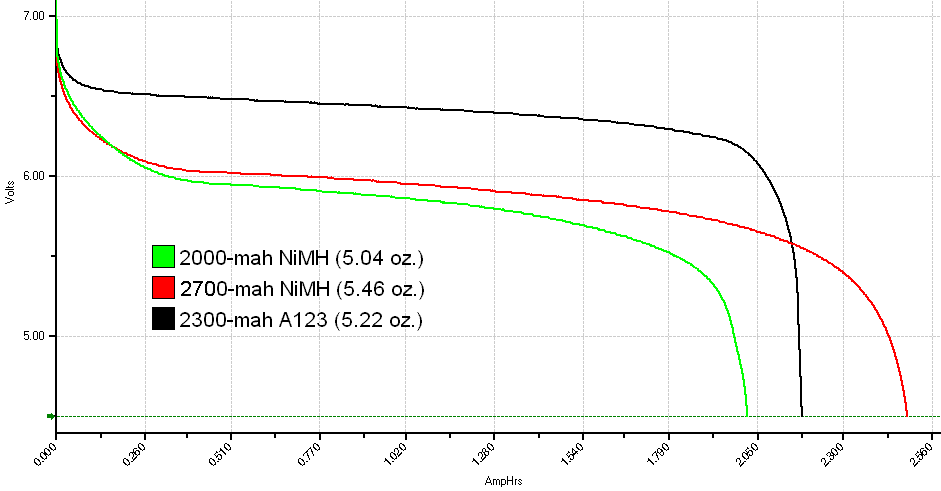 |
|
The graph above shows a 2-cell A123 pack using their original 2300-mah cells (from a DeValt 36V pack).
Also shown are our two NiMH packs.
All were discharged at 2 amps.
The NiMH packs had up to a 20-degree rise during discharge.
The A123 pack had no more than a 1-degree rise.
The A123 pack has a much flatter discharge curve, meaning servo performance will be more consistent.
The negative side is that it's harder to discern when the pack is nearing empty.
A prudent flyer will learn when to charge and how to leave plenty of margin.
Charging after the first flight and noting the mah required is a good way to understand what your limits are.
An advantage of the A123 cells is that you can recharge them in a small fraction of the time of NiMH.
To address the issue of determining remaining charge,
we have developed a circuit that continuously monitors current in and out of the pack,
providing a visual indication of the charge state,
as well as a throttle alert.
At least two other observations can be made of this graph.
The first is that the capacity of the Sanyo pack is higher.
Technically it is, but with the falling voltage, you have no business letting your pack get this low.
The second is that the A123 voltage is significantly higher than the others.
Is this voltage too high for the equipment?
|
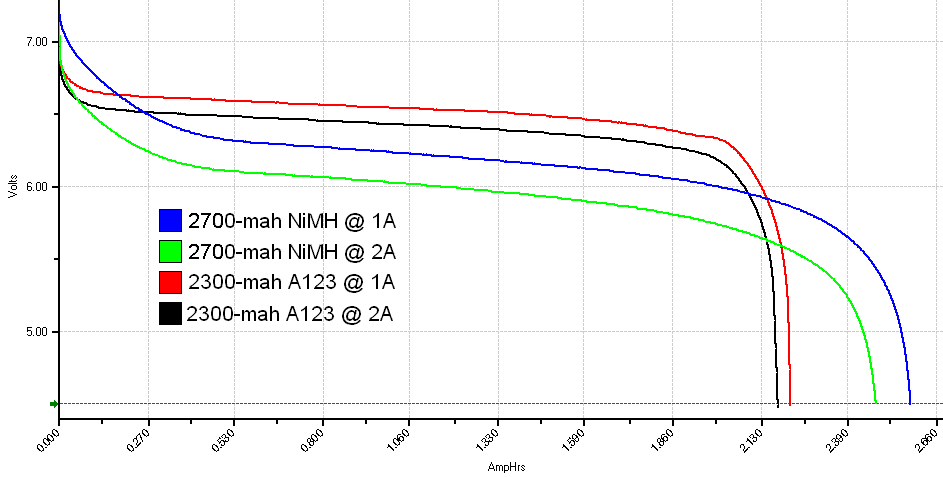 |
|
The curves above show the lower internal resistance of the A123 pack versus the better of our NiMH packs. It also shows that as loads are reduced, both chemistries have similar voltages. It is also clear the the NiMH pack can have a higher voltage during the first part of discharge. This means that there should not be a voltage problem with A123 if there is none with Ni*. |
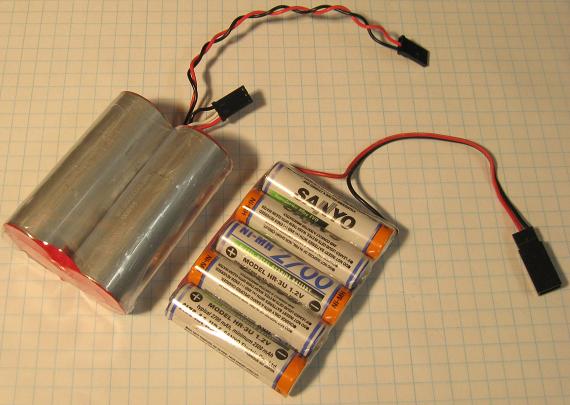 |
|
The photo above compares the A123 and Sanyo NiMH packs. The A123 pack has about the same footprint but is twice as tall. This is not an issue for the larger planes for which is is intended. You can make a pack with larger NiMH cells that have comparable internal resistance to the A123 pack, but it would be twice the size and over twice the weight. You could charge the larger pack in an hour. Charging a AA pack in an hour would be a death sentence. Like I said, I'm an A123 advocate, albeit unpaid. You can see how I made my pack elsewhere on this site. Do a web search for other opinions/techniques. |
|
We have been comparing AA Ni* cells to the A123. A better choice is the A-size NiMH. These cells have a lower resistance and can take a faster charge. This size pack weighs a bit more (6.9 oz. vs. 5.5) and is somewhat larger, as shown below. |
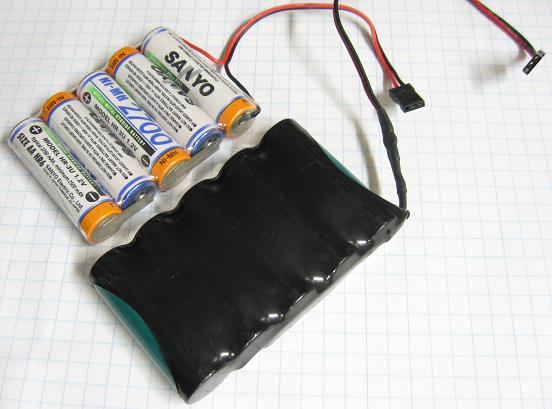 |
|
The graph below shows that the "A" packs definitely outperform the "AA" packs, but the A123 pack has the lowest resistance and flattest discharge curve. A better choice is the A-size NiMH. These cells have a lower resistance and can take a faster charge. This size pack weighs a bit more (6.9 oz. vs. 5.5) and is somewhat larger, as shown below. |
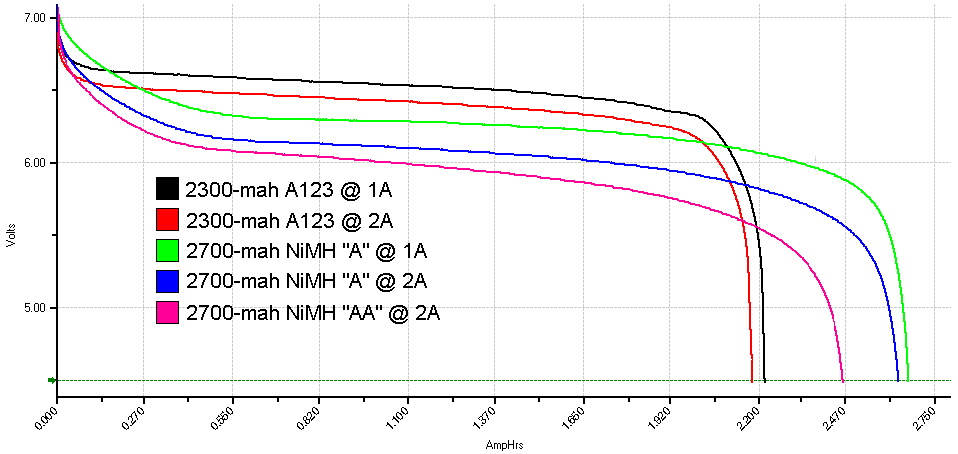 |
|
Some time ago, A123 developed a smaller cell, presumably for Black & Decker. Black & Decker introduced a line of small electric tools called VPX and powered by a 2-cell, 7-volt "VPX pack". These cells are the same length as the original cells (2.55"), but 0.73" versus 1.03". They have a capacity [advertised] of 1100-mah, and necessarily higher internal resistance. Unfortunately, Black & Decker has discontinued the VPX line. Packs for sale at WalMart last fall for less than $10 should have been a clue. The packs can still be purchased on-line from B&D, and a web search indicates several other retail sources. |
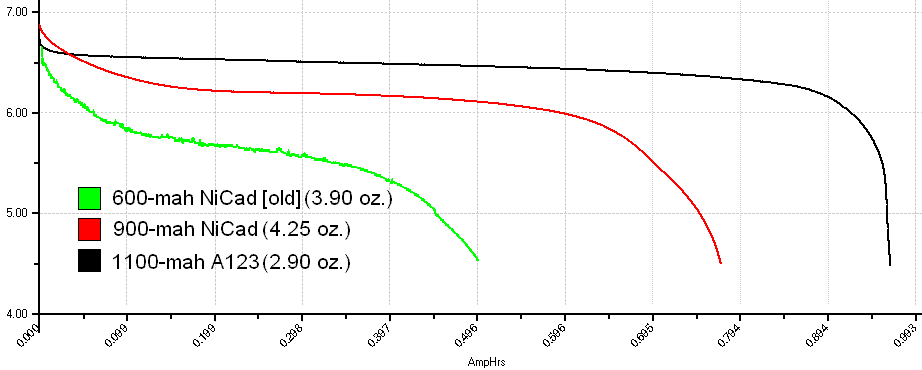 |
|
The graph above compares an old 600-mah NiCad pack and a new 900-mah NiCad pack to a 2-cell VPX pack. The old pack looks pretty sorry. When was the last time you checked your receiver pack's performance? None of the packs meet their advertised capacity, but the VPX pack has similar performance to the A123 2300 pack. You can see how I made my pack elsewhere on this site. Do a web search for other opinions/techniques. |
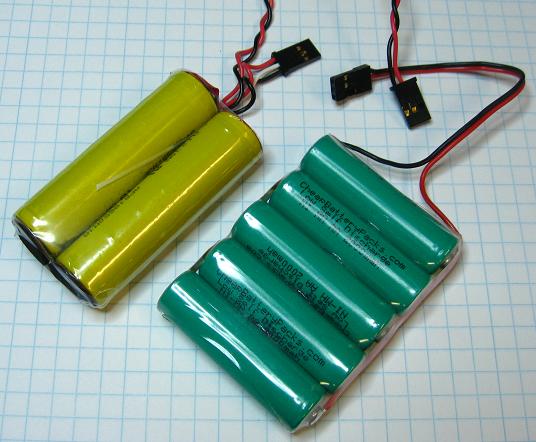 |